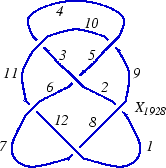Planar Diagrams: Difference between revisions
DrorsRobot (talk | contribs) No edit summary |
DrorsRobot (talk | contribs) No edit summary |
||
| Line 34: | Line 34: | ||
<!--$$K = PD[X[1,9,2,8], X[3,10,4,11], X[5,3,6,2], X[7,1,8,12], X[9,4,10,5], X[11,7,12,6]];$$--> |
<!--$$K = PD[X[1,9,2,8], X[3,10,4,11], X[5,3,6,2], X[7,1,8,12], X[9,4,10,5], X[11,7,12,6]];$$--> |
||
<!--Robot Land, no human edits to "END"--> |
<!--Robot Land, no human edits to "END"--> |
||
{{ |
{{In| |
||
n = 4 | |
|||
in = <nowiki>K = PD[X[1,9,2,8], X[3,10,4,11], X[5,3,6,2], X[7,1,8,12], X[9,4,10,5], X[11,7,12,6]];</nowiki>}} |
|||
{{In2}} |
|||
<!--END--> |
<!--END--> |
||
| Line 79: | Line 79: | ||
<!--$$K1 = PD[X[1,9,2,8], X[3,10,4,11], X[5,3,6,2], X[7,1,8,13], X[9,4,10,5], X[11,7,12,6], P[12,13]];$$--> |
<!--$$K1 = PD[X[1,9,2,8], X[3,10,4,11], X[5,3,6,2], X[7,1,8,13], X[9,4,10,5], X[11,7,12,6], P[12,13]];$$--> |
||
<!--Robot Land, no human edits to "END"--> |
<!--Robot Land, no human edits to "END"--> |
||
{{ |
{{In| |
||
n = 9 | |
|||
in = <nowiki>K1 = PD[X[1,9,2,8], X[3,10,4,11], X[5,3,6,2], X[7,1,8,13], X[9,4,10,5], X[11,7,12,6], P[12,13]];</nowiki>}} |
|||
{{In2}} |
|||
<!--END--> |
<!--END--> |
||
Revision as of 11:46, 30 August 2005
In the "Planar Diagrams" (PD) presentation we present every knot or link diagram by labeling its edges (with natural numbers, 1,...,n, and with increasing labels as we go around each component) and by a list crossings presented as symbols where , , and are the labels of the edges around that crossing, starting from the incoming lower edge and proceeding counterclockwise. Thus for example, the PD presentation of the knot above is:
(This of course is the Miller Institute knot, the mirror image of the knot 6_2)
(For In[1] see Setup)
|
| ||||||||
| ||||
Thus, for example, let us compute the determinant of the above knot:
In[4]:=
|
K = PD[X[1,9,2,8], X[3,10,4,11], X[5,3,6,2], X[7,1,8,12], X[9,4,10,5], X[11,7,12,6]];
|
In[5]:=
|
Alexander[K][-1]
|
Out[5]=
|
-11
|
Some further details
| ||||
| ||||
| ||||
For example, we could add an extra "point" on the Miller Institute knot, splitting edge 12 into two pieces, labeled 12 and 13:
In[9]:=
|
K1 = PD[X[1,9,2,8], X[3,10,4,11], X[5,3,6,2], X[7,1,8,13], X[9,4,10,5], X[11,7,12,6], P[12,13]];
|
At the moment, many of our routines do not know to ignore such "extra points". But some do:
In[10]:=
|
Jones[K][q] == Jones[K1][q]
|
Out[10]=
|
True
|
| ||||
Hence we can verify that the A2 invariant of the unknot is :
In[12]:=
|
A2Invariant[Loop[1]][q]
|
Out[12]=
|
-2 2
1 + q + q
|







